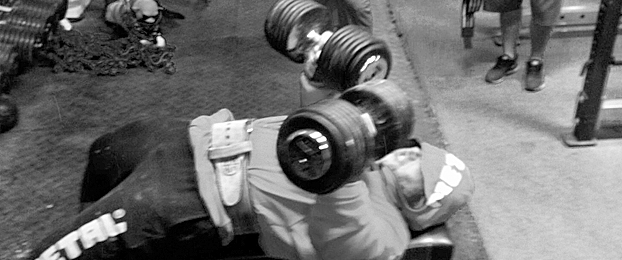

There is much literature circulating on how to increase our performance on the platform. There was and always will be the “gym guru” and his list of “myths” or the trainer/coach who has never even moved his own body weight under the bar. Watch how your prospective training partners lift. Find out about their goals, performance, and plan for success. There is valid science out there that can help you succeed.
Basically, success is a simple formula. The difficult part is the hard work and dedication that is required. This hard work is made much easier by a good attitude, an ethic toward improvement, and a set plan of action. There is nothing worse than having all of your sweat, blood, time, and energy wasted by substandard performance when a little individual “tweaking” and some variance would have made the difference.
During the 2004 AAPF Nationals, I severed a bicep tendon on my deadlift opener. I feel this could have been prevented by a little change in training. The worst part of the injury was that I failed myself and wasted a lot of training.
Sports performance has been overloaded with catch phrases over the past couple of decades. One mainstay of training is a valid periodization scheme. Periodization has become a fancy catch phrase and has been presented in a diluted manner to athletes. Attend any “sports performance facility” and you’ll hear or read the word “periodization” somewhere. It is a fancy word that has little or no meaning unless you utilize a scientific and valid plan.
Following a carefully charted plan will help you accomplish your goals on the field of competition or on the platform. Not only does this plan direct your physical training, your rest, your recovery, your diet, and injury prevention but also your mental preparation. The purpose of this plan is to get you ready to perform at peak performance in the best physical and mental shape possible. It is just as important to train your mental skills as your physical ones
There are several areas of mental preparation that should be taken into consideration when cycling for the meet. Remember, you are a conscious participant in your training process, not a robot lifting a monotonous number of sets and reps from a generic template. You have to train the “muscle” on top of your shoulders.
Very important and rarely practiced is visual realization during training. The lifter should practice visually performing the technically perfect lift many times prior to competition. Part of this training should be coordinated when training the lifts during the pre-competition phase. Successfully practice your lifts in your mind. Lifts are simpler and easier if you have done them before.
Another area of mental preparation is your physical environment. Don’t worry about things you can’t control. We can’t let the warm-up equipment, lifting room, platform, rack, or any other environmental object that is out of our control bother us. We have to have the maturity and mental resilience to deal with these factors in a positive manner. You can’t change it so deal with it.
You can help yourself adjust to environmental changes by varying where you train. I would train at my gym during the week, and on the weekends, I would travel an hour away to train at another facility where the people, equipment, and energy were different. The mind adapts as well as the rest of the body. Adaptation is our enemy when it becomes routine and leads to plateaus. Variety of training keeps you from boredom and staleness. This is part of your plan for success.
Negativity is more an enemy than any other deficient training factor. Negativity spreads like a virus through the gym, affecting your training partners and tragically your mind. Many times we don’t realize what is negative, but the seed is planted in our psyche. Negativity must be avoided throughout your training cycle and the competition. When someone starts complaining about injuries, facilities, or equipment, get away from them. Physically separate yourself from negative actions or words. This is particularly important at the meet. Even subtle negativity plants doubt in our minds. A subtle example would be your friend or coach saying, “don’t look up at the head judge until you are ready to lift” versus a positive approach like “look at the judge after you are firmly set and ready to lift.”
After discussing briefly several factors effecting performance, we come to the one thing you can do to help solidify your quest for success. Once you are on the platform, concentrate only on your set up. If you try to think about performing the whole lift, you will increase your likelihood of missing it. Your body and mind will not work at the same speed if you try to think your way through the lift. You have practiced the lift many times mentally and physically so let your training take over.
Many elite lifters don’t remember the step by step portion of a record setting lift because it became mechanical once they commenced lifting. As an example during the squat, concentrate on your foot placement; taking the bar on the proper part of your back; locking your hips, legs, and back; and letting the bar settle. Now the euphoric feeling of balance in mind and body takes over, and you are ready to perform.
Powerlifting is truly an individual sport. Your performance isn’t a reaction to another competitor as in wrestling and tennis. It isn’t a “fringe sport” as some might describe it. It’s the world’s strongest sport. Use the available science. Train with realistic expectations. Eat well, rest, and train the mental aspect of your sport.








